The unlikeliest expedition on Earth
How 20 ordinary people crossed the Scandinavian Arctic by dog sled.
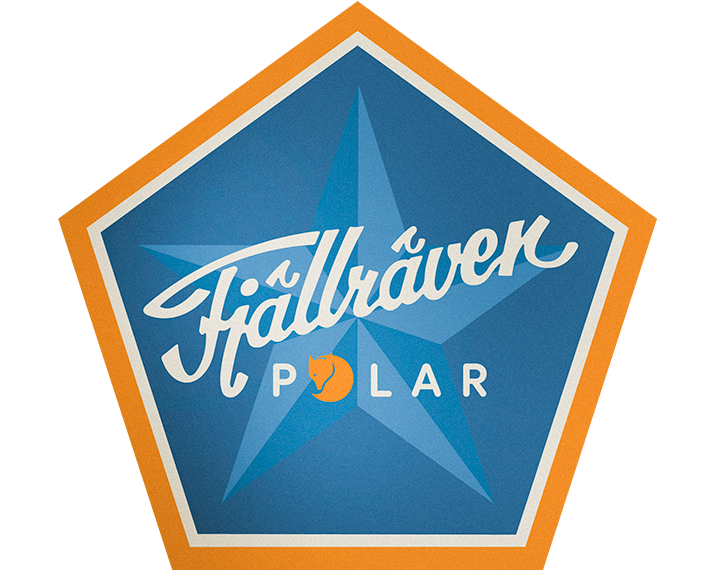
It’s 07:30 on the first Tuesday of April 2023, deep in the wild landscapes of the Scandinavian Arctic. This morning’s blizzard is proving a challenge for 20 explorers who are preparing for the final leg of a 300km dog sledding expedition across a vast and mountainous region. Battling against the howling wind and icy snow caked onto their fur-trimmed hoods, they work together to dismantle their tents and pack their sleds. For the last four days, they’ve travelled across frozen lakes, through dense pine forests and past sacred Sámi mountains. Their bodies are sore, their lips chapped, and their faces wind-burned from the gales of yesterday’s journey.
Their dogs, now in lines of two-by-two, can sense the impending departure. They howl, leap and rile around in the snow, eager to pull their adventurers deeper into the mountains and towards the finish line which lies 60km north and over the Norwegian border. Once they leave camp, one sled behind the other, any trace of their presence here will quickly be covered by fresh snow.
But these adventurers are not all they seem. Surviving in these polar landscapes has been a brand new experience for the majority of these 20 people. Among them is Mark Thompson, a primary school teacher and Scout leader based in Ireland; Nooshin Hamzehloo, an Iranian-born tax auditor based in Stockholm, and Katrin Riedmayr, a climate protection manager from Germany. There’s also French photographer, Conrad Vitasse, and Kert Kivaste, a self-proclaimed technophile from Estonia. Between all 20 of them, they represent 13 different countries – and while they each have their own personal reasons for being here, a single vision unites them: diving headfirst into a once-in-a-lifetime adventure to truly test themselves and discover what it means to become an Arctic explorer.
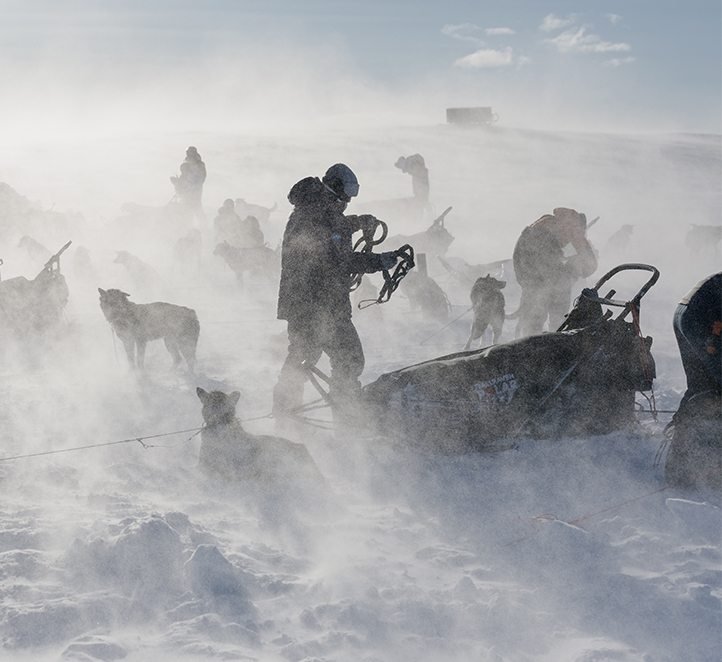
A call to the wild
In December 2022, these participants earned their spot on Fjällräven Polar 2023, an annual, all-expenses-paid polar expedition. For those who want more wilderness in their lives, the premise is simple: anyone, based anywhere in the world can apply for a place on the expedition through an online competition. For Fjällräven, the event aims to demonstrate that with the right equipment and knowledge, anyone can learn to appreciate and enjoy nature in arctic conditions, regardless of previous outdoor experience. It’s designed for ordinary people who want to do extraordinary things, with a little help from a small team of experts and 180 Alaskan sled dogs.
This year, the 300km route would begin at the dog kennels owned by Kenth Fjellborg, one of Sweden’s most accomplished mushers who has been part of Fjällräven Polar since it started in 1997. It’s here that each participant is given a sled, a team of six dogs and all the instructions they need. They cover steering, breaking, balance, as well as harnessing and positioning the dogs on the gang line, two by two.
From the kennels, the route would take them north towards the Norwegian border. Over five days, the constantly changing landscapes would keep everyone on their toes. The snow would get deeper, the frozen lakes would get bigger, and the tundra vaster. They would travel across the same lands that generations of Sámi reindeer herders have inhabited, becoming totally disconnected from their everyday routines back home. Eventually, they’d travel beyond the forests of the lowlands and head above the treeline and into the mountains. Here, they would need to work hard with their dogs as a united team in tough, uphill and exposed terrain that would test their limits as well as their energy reserves. The final destination would come after a dramatic descent into the small Norwegian village of Signaldalen.
But there was a lot to do before then.
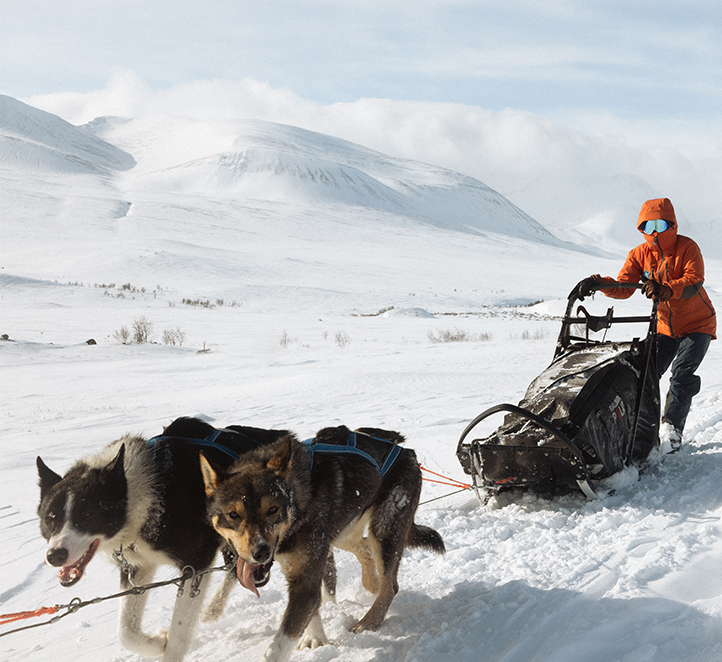
To the north
On day one, the 20 Arctic newcomers are split up into smaller teams of four. They quickly need to learn how to work, live and travel together throughout the expedition. After getting to grips with the basics of dog sledding, the teams travel to the frozen lake of Väkkäräjärvi and fall into a rhythm that gets a little more familiar by the day: sleds are tied off, the dogs are moved and settled, and their harnesses are replaced with a relaxing slip-on coat. Expedition tents are unpacked and erected, stoves are lit to start melting snow for dinner, dog food is chopped, warmed up and given to the pack; later, the team eats dinner, more water is boiled for breakfast the next morning, and sleeping bags and mats are unfurled for a night in the wild.
Out here, there’s never nothing to do. At sunrise, the routine starts again: stoves are fired up to boil water, the dogs are fed, the tents are taken down, the dogs are put back into their harnesses, more water is boiled, the dogs are relocated to the sled’s gang lines, and the sleds are packed, making sure essentials like snacks and water are in easy to reach places once they’re on the move. On the morning of day two, it takes the teams three hours to pack up camp and leave. But progress is fast. By day three, the teams knock an hour off their departure time as they ease into life in the Arctic, their dogs, their equipment and each other.
Thanks to their pre-expedition training, the teams have acquired all the know-how they need to survive. Nevertheless, they’re constantly reminded of the golden rules. Rule number one: do not let go of the sled. The dogs are built for running and they won’t stop once they’re on the go. Rule number two: do not get wet. Getting wet, and subsequently frozen in Arctic conditions could mean an abrupt end to the expedition. In such extreme places, small, seemingly insignificant, things like a wet glove, a missing water bottle or a lost spoon can be hugely problematic for a team. “Everyone has to give everything, otherwise it won’t work out. We would be late, the dogs would be hungry, we would have nothing to eat or drink – we each have our own role to play,” Katrin explains. “The first day we had a problem with a spoon that went missing. So there was a small disagreement there. But now, everything has its place. We’ve managed to get over such little things.”
As the teams travel north, they soak up the experience of disconnecting from their world back home. There are tired but happy faces as nine-to-five desk jobs are replaced with simple but crucial tasks like fetching water from a hole in the ice or kneeling on packed down snow to chop up frozen dog food with a small axe. Mark is often on snow digging duty: “Everything is digging. Digging snow paths, digging for the kitchens. Usually, you make dinner then go and watch TV for an hour. You can't do that here.”
As the days go by, many participants reflect on their lives back home. Others are focused purely on the present moment. For everyone though, at the heart of the expedition is a chance to reflect on life and a unique adventure, together. Over five intense days, the participants transition from perfect strangers to the tightest of teams, and for some, friendships take root that will go beyond the boundaries of life in the Arctic Circle.
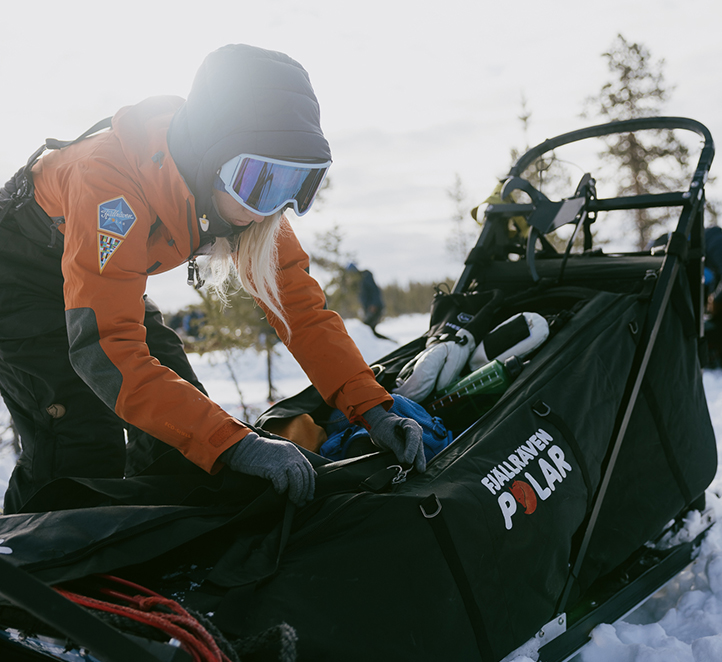
From strangers to support systems
As the expedition progresses, the days on the sled get longer and the terrain becomes more complex, forcing the teams to put their dog sledding techniques to the test. Eventually, the physicality of the journey takes hold. There are sore knees from walking in deep snow, sore fingers from prolonged exposure to the cold, and sore arms from holding onto the sled for hours at a time. It is, after all, a new experience for many of them. “This morning, I felt my ankles and my knee hurt a little. I want to keep going, but I feel like my body is experiencing something new,” explains Conrad. His eyes widen and he smiles: “But it’s an amazing feeling being here. I feel we’re connected to nature, to our teammates, to the dogs, to ourselves – it’s fantastic.”
Camaraderie evolves quickly. The teams help each other navigate expedition life with every challenge, knock and occasional fall. The Arctic isn’t the most conventional of locations for getting to know someone, and on this expedition, everyday chit-chat is non-existent. Instead, it’s replaced with prioritising the dogs, the team and constantly planning the next move: who has the shovel? Are the dogs harnessed properly? Who has spare sun cream? Who’s on kitchen duty? In this unique environment, the teams support each other, step up when others are struggling, and look out for one another while driving their sleds. This seems to peak on day four, when the teams travel over 65km through tough terrain, much of it uphill and exposed. The wind picks up, blowing away the snow to bare ice in places. Confidence sinks by lunchtime and the mental toll of the journey is exposed: “My sled is all over the place, I’m not sure what I’m doing wrong. Because it’s icy, my boots slip off the brake where I’m standing – maybe I’m too far forward because I’m tense. Maybe I need to be a bit further back, but then I might fall off. It’s still amazing, but I’m quite sore,” explains Becky Chapman, a professional sea kayaker from the UK. Her doubts subside however, when talking about her team: “Our team vibe is great. We all get on really well and muck in and help each other. We’ve gelled brilliantly. Sweden has at least another five residents after this. We’re all moving here!”
Jon Ayche from France also shares how his team has supported each other on the longest day so far: "We help each other very much. The cold can affect people and it’s a harsh environment, so I try to remind myself and the others that it’s a beautiful opportunity to be here. To be able to wake up and sleep under the stars is amazing.”
Jon's team is guided by Norwegian, Roy Ugseth, a professional musher who explains the mental and physical challenges of long-distance dog sledding: “It’s very physical. You're exposed to harsh weather, and you need to be able to keep motivating yourself and the dogs – and that’s not easy when you lack sleep and you're going for several days. But that’s when you find some part of you that you didn’t know existed. You can do so much more than you think you can.”
And that’s exactly what the teams do.
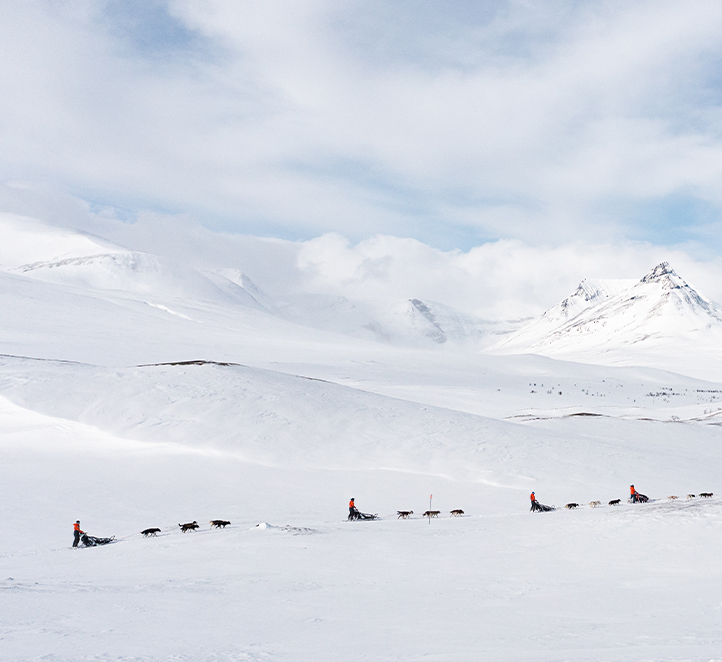
The Polar Effect
By the time the teams reach the highest and final camp of the expedition, they're used to their new life in the Arctic. They know the personalities of each of their six dogs and have grown used to the cacophony of howling in the evenings and the early morning. It’s a unique kind of alarm clock.
On the final morning, the sun fights to break through the clouds. At times the winds blow the snow into wave like formations that skim over a vast white desert landscape. Bright orange tents are taken down and flap wildly in the wind before being packed away. The teams are forced to shout from somewhere within their snow-clad fur hoods to make themselves heard. They’re tired, but there’s excitement, knowing that 60 kilometres away is the Fjällräven Polar finish line, which has been a long and hard-earned five days in the making.
They travel past the Swedish Norwegian border and surrounded by moody, craggy peaks, they start their long descent back into civilisation and the end of the expedition where lines of Fjällräven Polar flags signal that they’ve finally made it. There are tears and tight hugs with teammates. There’s pure exhaustion and pride on everyone’s faces, and later, touching goodbyes with the dogs who have brought them so far. “I’ve never felt more free than when I was mushing my team of six amazing sled dogs through landscapes I could never have dreamt of. I’ll never forget it,” says American, Katie Baker, a first-time visitor to Europe who wanted to prove to herself that she could do hard things.
After the all-important team photos and once their equipment is returned, everyone clambers onto a bus that will take them to Tromsø. Civilisation seems alien to them after being so immersed in the wild grandeur of the Scandinavian Arctic. There are broad smiles as the teams walk down the bus aisle and take their seats, their faces a similar mixture of joy, relief, satisfaction, and a shared fatigue after the initial high at the finish line. But as the bus pulls away, someone at the back of the bus has just enough energy to let out a long and proud howl, just like their beloved dogs. And like a true pack, the others on the bus lift their heads and join in. When words can’t explain the experience they’ve shared, somehow howling does.
From strangers, to teammates, to Arctic explorers.

Watch what happened on the 2023 expedition
Related articles
Join the adventure of a lifetime

